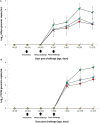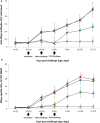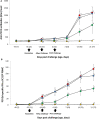A Dual Swine Challenge With Porcine Circovirus Type 2 (PCV2) and Mycoplasma hyopneumoniae Used to Compare a Combination of Mixable Monovalent PCV2 and Monovalent M. hyopneumoniae Vaccines With a Ready-to Use PCV2 and M. hyopneumoniae Bivalent Vaccine
- PMID: 32984414
- PMCID: PMC7492382
- DOI: 10.3389/fvets.2020.00579
A Dual Swine Challenge With Porcine Circovirus Type 2 (PCV2) and Mycoplasma hyopneumoniae Used to Compare a Combination of Mixable Monovalent PCV2 and Monovalent M. hyopneumoniae Vaccines With a Ready-to Use PCV2 and M. hyopneumoniae Bivalent Vaccine
Abstract
The present study evaluated the efficacy of swine vacciation using a combination of mixable monovalents for porcine circovirus type 2 (PCV2) and Mycoplasma hyopneumoniae against a ready-to-use bivalent vaccine under experimental conditions. Pigs at 21 days of age were administered either a combination of two mixable monovalent vaccines or a bivalent vaccine containing PCV2 and M. hyopneumoniae. Vaccination was followed with an M. hyopneumoniae challenge at 42 days of age (-14 days post challenge, dpc) and a PCV2d challenge at 56 days of age (0 dpc). Each vaccinated and challenged group was compared with the unvaccinated and challenged group for clinical, microbiological, immunologic, and pathologic differences. Clinically, two vaccinated and challenged groups showed minimal respiratory diseases that was characterized by occasionally coughing and sneezing. A significant difference was not calculated in the average daily weight gain, nasal shedding of M. hyopneumoniae, and pathological lesions between two vaccinated and challenged groups. A combination of two monovalent vaccines mixed into a combo prior to vaccination followed by challenge resulted in increased numbers of PCV2d-specific interferon-γ secreting cells at 21 dpc and a significant reduction in PCV2d viremia at 14 dpc when compared with the ready-to-use bivalent-vaccinated and challenged groups. These results offer supporting evidence that vaccination during the weaning to finishing period against M. hyopneumoniae and PCV2 is efficacious for controlling diseases caused by these two pathogens.
Keywords: Mycoplasma hyopneumoniae; bivlent vaccine; dual challenge; porcine circovirus type 2; porcine respiratory disease complex; swine; vaccination.
Copyright © 2020 Yang, Oh, Park, Cho and Chae.
Figures




Similar articles
-
Efficacy comparison of commercial porcine circovirus type 2 (PCV2) and Mycoplasma hyopneumoniae monovalent and bivalent vaccines against a dual challenge.Can J Vet Res. 2020 Oct;84(4):272-282. Can J Vet Res. 2020. PMID: 33012976 Free PMC article.
-
Comparison of 3 vaccination strategies against porcine reproductive and respiratory syndrome virus, Mycoplasma hyopneumoniae, and porcine circovirus type 2 on a 3 pathogen challenge model.Can J Vet Res. 2018 Jan;82(1):39-47. Can J Vet Res. 2018. PMID: 29382967 Free PMC article. Clinical Trial.
-
Evaluation of the efficacy of a trivalent vaccine mixture against a triple challenge with Mycoplasma hyopneumoniae, PCV2, and PRRSV and the efficacy comparison of the respective monovalent vaccines against a single challenge.BMC Vet Res. 2019 Oct 16;15(1):342. doi: 10.1186/s12917-019-2091-6. BMC Vet Res. 2019. PMID: 31619295 Free PMC article.
-
Porcine respiratory disease complex: Interaction of vaccination and porcine circovirus type 2, porcine reproductive and respiratory syndrome virus, and Mycoplasma hyopneumoniae.Vet J. 2016 Jun;212:1-6. doi: 10.1016/j.tvjl.2015.10.030. Epub 2015 Oct 23. Vet J. 2016. PMID: 27256017 Review.
-
Influence of vaccination against infectious diseases on the carbon footprint of fattening pigs: a systematic review.Front Vet Sci. 2024 Dec 18;11:1487742. doi: 10.3389/fvets.2024.1487742. eCollection 2024. Front Vet Sci. 2024. PMID: 39744710 Free PMC article.
Cited by
-
A Comparative Field Evaluation of the Effect of Growth Performance Between Porcine Circovirus Type 2a (PCV2a)- and PCV2b-Based Bivalent Vaccines Containing PCV2 and Mycoplasma hyopneumoniae.Front Vet Sci. 2022 Jun 24;9:859344. doi: 10.3389/fvets.2022.859344. eCollection 2022. Front Vet Sci. 2022. PMID: 35812885 Free PMC article.
-
Comparative growth performance of 3 types of combination vaccines containing porcine circovirus 2 and Mycoplasma hyopneumoniae under field conditions.Can J Vet Res. 2022 Apr;86(2):93-101. Can J Vet Res. 2022. PMID: 35388232 Free PMC article.
-
A field evaluation of a new porcine circovirus type 2d and Mycoplasma hyopneumoniae bivalent vaccine in herds suffering from subclinical PCV2d infection and enzootic pneumonia.Vet Med Sci. 2024 Sep;10(5):e70001. doi: 10.1002/vms3.70001. Vet Med Sci. 2024. PMID: 39189840 Free PMC article.
-
Evaluation of the protective efficacy of six major immunogenic proteins of Mycoplasma Synoviae.Front Vet Sci. 2024 Jan 4;10:1334638. doi: 10.3389/fvets.2023.1334638. eCollection 2023. Front Vet Sci. 2024. PMID: 38239753 Free PMC article.
-
Efficacy of Two Commercial Ready-To-Use PCV2 and Mycoplasma hyopneumoniae Vaccines under Field Conditions.Animals (Basel). 2021 May 26;11(6):1553. doi: 10.3390/ani11061553. Animals (Basel). 2021. PMID: 34073385 Free PMC article.
References
-
- Thacker EL. Porcine respiratory disease complex what is and why does it remain a problem?. Pig J. (2001) 48:66–70.
LinkOut - more resources
Full Text Sources

